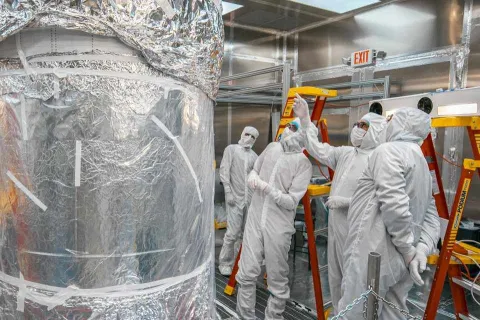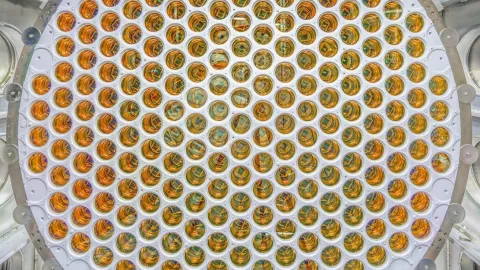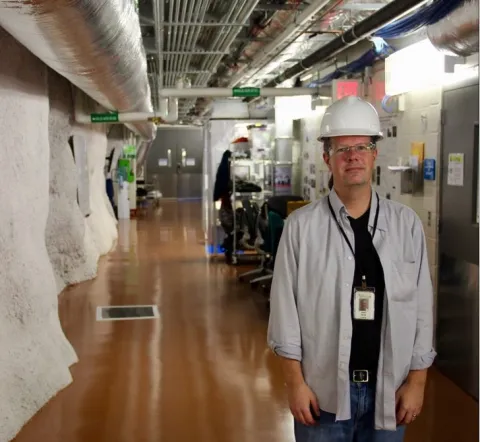LUX-ZEPLIN: the new experiment hoping to detect dark matter
BBC's Sky at Night spoke to Jaret Heise about an experiment aiming to make the first direct detection of dark matter
This article has been adapted from its original version published by BBC Sky at Night on Sept. 16, 2019.
A mile below Earth’s surface at the Sanford Underground Research Facility (Sanford Lab) in South Dakota, US, something exciting is happening. There, scientists are carrying out an experiment named LUX-ZEPLIN (LZ), with the aim of making the first ever detection of the elusive substance known as dark matter.
Dark matter can’t be directly observed: it currently can’t even be detected. Yet astronomers have inferred its existence by the way it interacts gravitationally with observable matter in the Universe.
In fact, that observable matter pales in comparison to the distribution of dark matter in the Universe, so finding out exactly what dark matter is, and how it can be detected, is one of the big questions that scientists are hoping to solve over the coming years.
We spoke to Jaret Heise, science director at the Sanford Lab, to find out exactly how the LZ experiment works and, if it is successful, what it might mean for our understanding of the Universe.
First off, tell us about the Sanford facility and the sort of work that is done there.
We’re a research facility dedicated to underground science; actually the deepest underground lab in the United States.
Our mission is to advance compelling and transformational science, and as the science director I get to interact with groups that are interested in trying to answer big questions.
Right now our facility currently supports 30 different experiments representing 80 institutions and 100s of researchers, so I would say I have the best job in the whole place!
What is the LUX-ZEPLIN experiment?
The LZ dark matter detector is built on the foundations of two previous experiments: the LUX experiment that operated at our facility and which was turned off in 2016 to make way for the upgrade, LZ.
ZEPLIN was another dark matter experiment that operated in the UK at the Boulby Underground Laboratory for many years and through many generations.
So combining the intellectual horsepower of those two operations has resulted in the LZ experiment that’s hosted at our facility just about a mile underground in the Davis Campus, which was created in 2012 when the LUX experiment was moved in to begin its data run.

The depth of the underground lab, in so far as affecting the physics of the experiment, is really to screen unwanted particles that would contribute background noise.
If you’re on the surface of Earth and you hold out your hand, you would expect two or three cosmic ray muons to pass through every second. Dark matter has almost certainly affected the formation of our Galaxy, and it plays a huge role in the evolution of our Universe.
Those muons are generated by cosmic ray particles interacting in the upper atmosphere, producing a shower of muons.
The muons are very energetic and would constitute a background noise if you were to do some of these really sensitive measurements looking for very rare processes on the surface.
Moving a mile underground in our case shields those background particles, reducing them by a factor of about ten million.
So rather than two or three on the surface, if you go underground on the Davis Campus, you’re looking at one of these cosmic ray muons per month, and if you’re a rare physics experiment trying to be the first to detect dark matter directly, you want to give yourself every advantage.
There’s no guarantee that nature will be so kind, but you couldn’t do these experiments on the surface in the way that they’re proposed.
How does the detector work?
The LUX-ZEPLIN is basically a big bucket full of xenon. The LUX detector before it was also a big bucket of xenon; this is a larger bucket of xenon!
LUX started with a third of a tonne – just over 350kg – and the LZ will have 10 tonnes; so a scaling-up of about 30 times.
The way the detector operates is that xenon both scintillates and becomes ionised when particles hit it, so you have an initial burst of light from the scintillation, the deposition of energy.
Those initial particles can be ones that we know about already; they could be beta particles, they could be neutrons. These are particles that are very familiar to us.
They could also be dark matter particles that interact very weakly, possibly just gravitationally, but maybe a little higher up in the interaction spectrum if they also interact weakly.

A lot of experiments these days are focussing on the weakly interacting massive particle, or WIMPs.
In the case of LZ, with 10 tonnes of xenon, the scientists are looking for bursts of light.
They’ll have light sensors, photomultiplier tubes on the top of the region and on the bottom of the region sandwiching the xenon, looking for signals that a particle has interacted with a xenon particle.
Based on the amount of light that’s given off in the initial scintillation burst, compared to a secondary ionisation measurement, they can determine what type of particle it is.
They can weed out the ones we know about already and look for the ones that we have never seen before.
Is it a process of elimination?
In a way, yes it is. It’s a process of understanding the detector extremely well.
In the case of experiments at our facility, moving a mile underground and away from that cosmic ray background is important.
Also, shielding from the natural radioactivity in the laboratory is important. Everything has radioactivity: the concrete, the paint on the walls, the people, the bananas that people bring for lunch: everything has a small amount of radioactivity.
The LZ experiment is planning to have their titanium vessel with 10 tonnes of xenon immersed inside a large water shielding tank.
LZ has innovated one additional detector as compared to the original LUX run. Here they’re going to use an additional liquid scintillator, and that will help them detect neutrons that are also generated naturally in the laboratory.
Neutrons are particularly dangerous background because they have no electrical charge and they’re relatively massive. So they can mimic the signal of a dark matter particle fairly well.
Understanding the response of the detector to neutrons is very important, and understanding the flux of neutrons that is present is also extremely important.
So it’s a process of elimination, but it’s also about understanding things that you can lay your hands on as best as you can: understanding the background of all the parts and pieces that went into constructing the detector.
We have low background counters at our facility where you would put in the nuts and bolts and light sensors and titanium samples and figure out in some cases what the best manufacturer is, and which one will give you the lowest radioactive components.
In some cases where you don’t have a choice and have already made a selection, you still want to understand how much intrinsic radioactivity is in that part or piece so that you can determine how much background you’ll see within your detector when you turn it on, so that you can then look for signals outside of that range.

Why do you think it’s so important that we do detect and understand more about dark matter?
Dark matter is a very important component of our Universe, as we have discovered.
There’s five times more dark matter in the Universe than the normal matter that we know and love: tables, chairs, planets, stars, galaxies. All of the normal matter makes up four per cent of the Universe.
We’re looking for something that is five times more plentiful.
It has almost certainly affected the formation of our Galaxy, and it plays a huge role in the evolution of our Universe.
Not only that, but we can train the next round of scientists on how to build the next round of detectors, so we’re training qualified personnel to work on these experiments.
It’s a great way to engage the public as well. Tell them about these cool particles no-one has ever seen before, and you can really get people excited about science.
So it runs the gamut from basic research to understanding our Universe, and who knows what we will be able to do with the information once we find dark matter. Are there different types of dark matter? Who knows.
Once we discover dark matter it’s probably not going to make our computers run faster or improve your TV resolution or things that people are looking at from a practical point of view, but knowing what the Universe is made of gives us that much more leverage to understand what we can do in the future.
Is dark matter everywhere? If someone is reading this interview, is it in the room where they’re sitting, for example?
We believe it is. If you had a 2 litre soda pop bottle, there would probably be something like one dark matter particle in that volume.
We believe it is ubiquitous through the Galaxy. Since it interacts gravitationally, there might be more of it in the centre of the Galaxy, and there are groups – other than LZ, which is looking for direct signatures – that are looking for indirect signatures.
Maybe the dark matter particles will collide, or maybe they can decay. Some satellite-based instruments are looking at the centre of the Galaxy because they expect there to be a higher concentration of dark matter in that area. But yes, we believe it’s all around us.
Do you think there could ever be a telescope built that would be able to directly observe dark matter?
I think you could have a visual representation, but I don’t know that we would ever see dark matter directly, the same way that we can’t directly see some of the lightest particles that we know of today.
Neutrinos would be a good example. We see them indirectly because of how they interact with other matter, whether they hit other charged particles and produce light that we can see with instruments.
Often we see these rare weakly-interacting signals only indirectly, but that doesn’t mean that we can’t represent them in some way and there are graphics showing what the dark matter concentration looks like in our Galaxy based on certain models.
So we have that ability, but actually seeing a dark matter particle directly with our own eyes? I’m sceptical about that!

If money were no object, would it be more scientifically advantageous to launch the LZ experiment into space?
The search for dark matter is multi-faceted, combining the efforts of underground scientists like we have here at Sanford Lab, accelerator scientists as well as satellites.
We’re all complementing each other in that search. The accelerator scientists are trying to reproduce a candidate particle that might be a weakly-interacting massive particle.
The satellites are looking for indirect signals of WIMP annihilation or decay of dark matter particles.
So we already are in space and we already are building some of the largest machines humans have ever made, coming at the search for dark matter in all the ways we can think of.
If money was no object for underground science, we would probably build a larger version!
But having said that, we’re already running in with the current set of experiments. The sensitivity of these instruments is so exquisite, that the search for dark matter is now going to be clouded to a certain degree by neutrinos coming from our Sun.
It’s a really interesting story at our facility because some of the first measurements of neutrinos coming from our Sun were performed by Ray Davis here in Lead, South Dakota, starting back in the 1960s, when he convinced the Homestake Mining Company to dig a big pit and help him install a detector for that purpose.
He had 100,000 gallons’ worth of dry-cleaning fluid to search for interactions of neutrinos over decades. Now those same neutrinos coming from the Sun are the background for searches for other particles.
That doesn’t mean that we can’t continue to look for dark matter with a bigger instrument, but going deeper won’t screen out the neutrinos. However, that doesn’t mean that the next version, a scale above the LZ experiment, wouldn’t be profitable.
What’s next for the project and do you have any idea when to expect the first results?
The collaboration is assembling the instrument. We have clean rooms in our surface facility and the inner components of the detector have been put together, inserted into the titanium inner vessel.
We expect to be able to transport that instrument underground around October 2019 and it’ll be installed in that large water shielding tank.
There’ll be a process for checking it out and making sure everything is working.
They hope to start taking physics data some time in 2020.
First results; I don’t want to speak for the collaboration but we hope to have the first result within a year of turning the instrument on, so maybe some time in 2021 we would look forward to the latest and greatest dark matter result, whether that’s a confirmation of a signal or pushing the boundaries of the sensitivity of instruments looking for dark matter.
